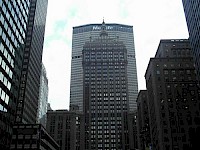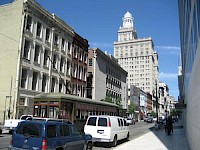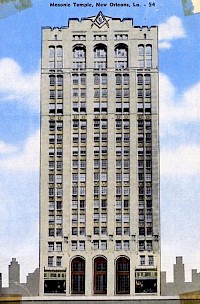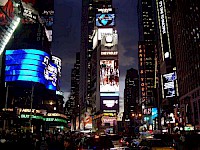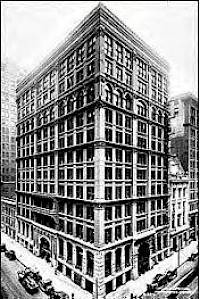Skyscrapers 101 to 110 of 228
The Hammond Building was Detroit's first skyscraper. It has since been demolished, to be replaced by the Bank One Building (Now named the Chase Tower). The location of the former building is at the corner of Griswold Street and West Fort Street, in downtown. The high-rise building was constructed in 1889, and destroyed in 1956 to make way for the National Bank of Detroit Building.
Harvard Square Building is located at 1344-1346 Broadway Street, in downtown Detroit, Michigan, next to the Merchants Building. It was built in 1925 and stands at 12 floors in height, designed in the Neo-classical architectural style with Romanesque accents. It is currently unused. The current plans for the building calls for a renovation that will include 21 loft apartments. Heritage National Investment has proposed converting the building into 21 residential loft apartments.
The Heaviest Corner on Earth is a promotional name given to the corner of 20th Street and 1st Avenue North in Birmingham, Alabama, United States, in the early 20th century. The name reflected the nearly-simultaneous appearance of four of the tallest buildings in the South, the 10-story Woodward Building (1902), 16-story Brown Marx Building (1906), 16-story Empire Building (1909), and the 21-story American Trust and Savings Bank Building (1912).
Some of the finest buildings in New Jersey, New York, and other large eastern cities were built by the Hedden Construction Company, one of the largest construction companies operating in Newark in the very early 1900s. Among the most notable is the Metropolitan Life Insurance Company Tower located at One Madison Avenue in New York, NY. The tower was the world's tallest building from 1909 to 1913 and home to the Hedden Construction Company's main offices located on the 36th and 37th floors.
The Helmsley Building is a 35-story located at 230 Park Avenue in New York City. Before the erection of the Pan Am Building, now the MetLife Building, this building stood out over the city's second most prestigious avenue as it was the tallest structure in the great "Terminal City" complex around Grand Central Terminal designed by Warren & Wetmore. The building was designated a New York City Landmark in 1987.
Hibernia Bank Building, located at 812 Gravier Street, in the Central Business District of New Orleans, Louisiana, is a 20-story, 355 feet (108 m)-tall skyscraper. It used to be the headquarters of Hibernia National Bank. At the time it was completed, it was the tallest building in the state of Louisiana.
The Higgins Building is a proto-Modernist building located in downtown Los Angeles, California. Built and owned by Thomas Higgins, an Irish American in 1909, the building was originally used for office space and years later was transformed into downtown lofts. The architects were Albert C. Martin, Sr. and A.L. Haley. The Higgins Building also houses one of Los Angeles' premier nightclubs in its basement, The Edison, which opened in 2007.
Hilton New Orleans , located at 333 St. Charles Avenue in the Central Business District of New Orleans, Louisiana, is a 20-story, 246 feet (75 m)-tall skyscraper. The hotel is part of the Hilton Hotels chain. The building was originally the Masonic Temple, but was sold in 1992 and redeveloped as Hotel Monaco until Hurricane Katrina. Hotel Monaco did not reopen after Katrina in the hotel reopened in 2007 as a Hilton.
HLW is an international architecture and design consultancy, with headquarters in New York City, with offices in Los Angeles, London and Shanghai. It is one of the longest-lived firms in the United States, tracing its beginnings to 1885 in New York. The firm traces its origins to 1885, when Cyrus L.W. Eidlitz worked on the design of the Metropolitan Telephone Buildings on Cortlandt Street in Manhattan.
The Home Insurance Building was built in 1885 in Chicago, Illinois, USA and destroyed in 1931 to make way for the Field Building (now the LaSalle National Bank Building). It was the first building to use structural steel in its frame, but the majority of its structure was composed of cast and wrought iron. It is generally noted as the first tall building to be supported, both inside and outside, by a fireproof metal frame.
The selector used to find the pages shown above is:
template=skyscraper, limit=10, year>=1800, year<=1930, sort=name

